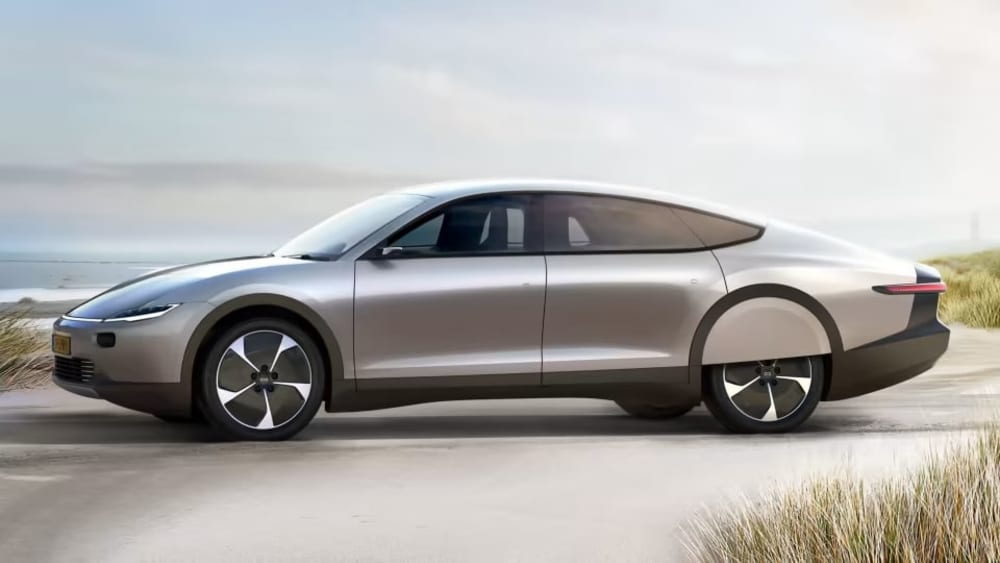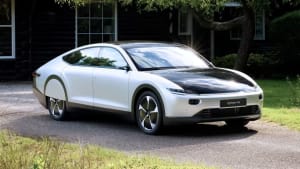Information and electric vehicles of the [object Object] brand

![[object Object] logo](https://res.cloudinary.com/donyiousk/image/upload/w_80/f_auto/c_scale,w_1400/v1/car/z8sxuonyvvjxraejuxnw)
Lightyear
Leave the gas, keep the grin.



Lightyear electric vehicles
What makes Lightyear EVs different from other brands?+
What makes Lightyear EVs truly unique boils down to three key factors:
1. Integrated Solar Panels: This sets Lightyear apart from any other mainstream EV brand. They boast built-in solar panels seamlessly integrated into the car's roof and hood, capturing the sun's energy to extend driving range. While the impact may vary depending on weather and driving conditions, Lightyear estimates the panels can add up to 70 kilometers of range per day – potentially leading to months of driving without needing to plug in.
2. Extreme Efficiency: Lightyear doesn't stop at solar panels. They've meticulously designed their EVs to be incredibly efficient in every aspect. This includes:
- Aerodynamic Design: With a record-breaking drag coefficient of less than 0.175, Lightyear 0 cuts through the air with minimal resistance, reducing energy consumption.
- Lightweight Construction: By using advanced materials and minimizing unnecessary weight, Lightyear EVs require less energy to move.
- Four In-wheel Motors: This innovative drivetrain system eliminates energy loss through traditional transmissions, maximizing efficiency.
3. Focus on Sustainability: Lightyear goes beyond just driving – they strive for a holistic approach to sustainable mobility. Their cars boast:
- Reduced Lifetime Emissions: Compared to conventional EVs, Lightyear claims their vehicles have a significantly smaller carbon footprint over their lifespan.
- Sustainable Materials: They prioritize using recycled and eco-friendly materials in their EVs.
- Reduced Resource Consumption: The efficient use of energy translates to less reliance on energy sources and infrastructure.
However, it's important to note some nuances:
- Current Focus on High-End Market: Lightyear's initial model, the Lightyear 0, was priced at €250,000, putting it firmly in the luxury car segment. While they're shifting focus to a more affordable Lightyear 2 with a planned price tag of €40,000, it's still not the most accessible option for all.
- Limited Production Currently: Production volumes are still small compared to larger car manufacturers, making Lightyear EVs less readily available.
What are the different models of Lightyear EVs available?+
As of today, January 3, 2024, there is only one Lightyear EV model available, the Lightyear 0. However, they do have another model, the Lightyear 2, that is currently in the pre-order phase.
Lightyear 0
The Lightyear 0 is a luxury solar electric car that was launched in 2022. It has a range of up to 700 kilometers 435 miles) on a single charge, and it can also add up to 70 kilometers (43 miles) of range per day from the sun. The Lightyear 0 is priced at €250,000 (about $265,000.
Lightyear 2
The Lightyear 2 is a more affordable solar electric car that is expected to be launched in 2025. It will have a range of up to 500 kilometers 311 miles) on a single charge, and it will be priced at less than €40,000 (about $42,000.
How much do Lightyear EVs cost?+
There are two relevant costs to consider when it comes to Lightyear EVs:
Lightyear 0 discontinued:
- Originally priced at €250,000 including VAT around $281,000 USD, production began in late 2022 but was discontinued shortly after due to a strategic shift towards the Lightyear 2.
Lightyear 2 coming in 2026:
- This is the more affordable option, with a starting price point below €40,000 around $44,800 USD. Pre-orders are open, and joining the waitlist gives you priority when sales begin.
Here's a quick summary:
| Model | Production Status | Price |
|---|---|---|
| Lightyear 0 | Discontinued | €250,000 |
| Lightyear 2 | Coming in 2026 | Starting at < €40,000 |
So, while the currently available Lightyear 0 was quite expensive, the upcoming Lightyear 2 aims to be much more accessible.
What is the range of Lightyear EVs?+
Lightyear EVs boast impressive range thanks to their unique "solar electric" approach, combining battery power with an integrated solar panel system. Here's a breakdown of their range capabilities:
Lightyear 0:
- Battery range: 625 km 388 miles according to the WLTP standard.
- Real-world range: Estimates vary based on factors like driving conditions and weather, but generally fall within the 390 km 242 miles) to 820 km (510 miles range.
- Additional daily solar range: Up to 70 km 43.5 miles in ideal sunny conditions.
- Annual solar yield: Up to 11,000 km 6,835 miles under optimal conditions.
Lightyear 2 not yet in production:
- Target range: 500 miles 805 km based on the WLTP standard.
- Expected real-world range: Likely to be within the 400-600 mile 644-966 km range based on Lightyear's claims and the 2's further focus on efficiency.
Things to remember about Lightyear EV range:
- The actual range achieved will depend on factors like driving style, weather, and terrain.
- The solar panel system's contribution to range will be highest in sunny climates.
- Lightyear EVs prioritize efficiency and long-range over fast charging, as their focus is on maximizing solar-powered driving.
Overall, Lightyear EVs offer exceptional range thanks to their efficient design and innovative solar technology. While charging will still be required for longer journeys, their ability to significantly extend range with sunlight makes them a compelling option for drivers who prioritize eco-friendly, long-distance travel.
How long does it take to charge a Lightyear EV?+
The charging time for a Lightyear EV depends on several factors, including:
The type of charger you use:
- Home charging:
- Wall plug 2.3 kW: 30 hours 45 minutes
- 1-phase 16A 3.7 kW: 12 hours
- 3-phase 22 kW: 3 hours 15 minutes
- Public charging:
- 50 kW DC fast charger: around 1 hour
- 75 kW DC fast charger: around 44 minutes up to 80% charge
The amount of solar energy collected:
- Lightyear 0 can generate up to 1.05 kW of solar power on a sunny day, adding 10 km of range per hour.
- In ideal conditions, this can contribute 50-70 km of range per day, significantly reducing charging time.
Other factors:
- Battery temperature: Colder temperatures can slow down charging.
- Battery health: Older batteries may charge slower than newer ones.
Therefore, there's no single answer to your question. However, to give you a general idea:
- Full charge with no solar power:
- Home wall plug: Over 30 hours
- Home 3-phase charger: Around 3 hours
- 50 kW DC fast charger: Around 1 hour
- Full charge with some solar power average sunny day:
- Significantly faster than without solar, depending on the amount of solar energy collected.
Here are some additional resources you might find helpful:
- Lightyear 0 Frequently Asked Questions: Link
- Lightyear 0 charging time, range, and cost: Link
What are the maintenance requirements for a Lightyear EV?+
The maintenance requirements for a Lightyear One EV are quite different from traditional gasoline-powered vehicles due to the nature of electric motors and the car's unique solar panel integration. Here's a breakdown of what you can expect:
General Maintenance:
- Tire rotations and alignments: Recommended every 6,000 miles or once a year, whichever comes first.
- Brake fluid flush: Every 2 years or 24,000 miles.
- Cabin air filter replacement: Every year or 12,000 miles.
- Wiper blade replacements: As needed when they show signs of wear or streaking.
Electric Vehicle Specific Maintenance:
- Battery pack health check: Lightyear recommends an annual inspection at a Lightyear Service Center to assess the battery pack's health and performance.
- Charging system check: The onboard charging system should be checked periodically for proper functionality and potential software updates.
- Electric motor checks: No routine maintenance is required for the electric motors themselves, but they will be inspected during the annual battery pack health check.
Solar Panel Maintenance:
- Cleaning: The solar panels should be kept clean for optimal efficiency. Lightyear recommends cleaning them with a soft cloth and water every few months or after long periods of rain or dust.
- Scratch and damage: Avoid scratching or damaging the solar panels, as this can affect their performance. If any damage occurs, consult a Lightyear Service Center for repairs.
Additional Points:
- Regenerative braking: Lightyear One's regenerative braking system helps extend the range by recovering energy during braking. However, it can also lead to increased wear on the brake pads. Monitor pad thickness regularly and replace them when necessary.
- Software updates: Lightyear may release software updates periodically to improve the car's performance and features. These updates can be installed over-the-air or at a Lightyear Service Center.
Warranty:
The Lightyear One comes with a 4-year/50,000-mile warranty on the battery pack and electric motor, and a 2-year/25,000-mile warranty on other components. This warranty covers manufacturing defects and repairs due to normal wear and tear.
It's important to note that this is just a general overview, and the specific maintenance requirements for your Lightyear One may vary depending on your driving habits and local conditions. Always refer to the owner's manual for the most up-to-date information and consult a Lightyear Service Center for any specific questions or concerns.
Does Lightyear offer any tax credits or incentives for purchasing an EV?+
Unfortunately, Lightyear itself doesn't offer any direct tax credits or incentives for purchasing their EVs. However, depending on your location and the specific Lightyear model you're interested in, there might be other tax benefits or incentives available for electric vehicle purchases. Here's a breakdown:
Location-specific incentives:
- Vietnam: As of January 2024, there are no specific tax incentives for electric vehicle purchases in Vietnam. However, the government is considering implementing some in the future, so it's worth staying updated on any policy changes.
- Other countries: If you're considering purchasing a Lightyear in another country, you should research the specific EV incentives offered there. Many countries have generous tax credits or rebates for EV purchases, which can significantly reduce the overall cost. For example, the United States offers a federal tax credit of up to $7,500 for purchasing an electric car, and some states offer additional incentives on top of that.
Lightyear One specific considerations:
- Limited production: The Lightyear One is currently in limited production, with only a few hundred vehicles delivered so far. This means that the availability of used Lightyear Ones might be limited in the near future, which could impact the depreciation rate and affect any potential tax benefits associated with purchasing a used EV.
- High price tag: The Lightyear One is a high-end electric vehicle with a starting price of around €150,000. This means that it might not qualify for all EV incentive programs, which often have income or price limitations.
Overall, while Lightyear itself doesn't offer any direct tax credits or incentives, there might be other options available depending on your location and the specific Lightyear model you're interested in. It's always recommended to do your research and consult with a tax professional to understand the full financial picture of purchasing an electric vehicle.
What is the warranty on a Lightyear EV?+
The warranty on a Lightyear EV, specifically the Lightyear 0, is outlined on their website at Link. The key points are:
Vehicle warranty:
- 4 years or 100,000 kilometers: This covers all defects in materials and workmanship of the vehicle itself, except for wear and tear items like tires and brake pads.
Battery warranty:
- 8 years or 200,000 kilometers: This covers any issues with the performance or capacity of the battery pack.
Solar panel warranty:
- 12 years: This covers any defects in the materials or functionality of the integrated solar panels.
Additional points:
- The warranty is transferable to subsequent owners of the vehicle.
- Certain components may have different warranty terms, so it's best to consult the complete warranty document for details.
- Lightyear offers extended warranty options for purchase.
If you have any specific questions about the Lightyear 0 warranty, you can contact Lightyear customer support directly.
Where can I learn more about Lightyear EVs?+
There are several great places you can learn more about Lightyear EVs:
Official website:
- Lightyear.one: This is the official website of Lightyear and your best source for the most up-to-date information about their vehicles. Here you can learn about their mission, technology, specifications, and news. You can also browse photos and videos of the Lightyear 0 and get details about the upcoming Lightyear 2.
Social media:
- Twitter: Follow @LightyearOne on Twitter for the latest news and updates from the company.
- Facebook: Like the Lightyear page on Facebook to see photos, videos, and articles about Lightyear EVs.
- YouTube: Check out the Lightyear YouTube channel for informative videos about their technology and vehicles.
Media articles and reviews:
- TechCrunch: TechCrunch has covered Lightyear extensively, including a recent article about their shift to focus on the Lightyear 2.
- Electrek: Electrek is another great source for electric vehicle news and reviews, and they have dedicated articles about both the Lightyear 0 and Lightyear 2.
- The Verge: The Verge has also written about Lightyear EVs, offering insightful reviews and analysis.
Additional resources:
- EV Database: The EV Database is a great resource for comparing different electric vehicles. You can find detailed specifications for the Lightyear 0 on their website.
- Lightyear 2 waitlist: If you're interested in reserving a Lightyear 2, you can sign up for the waitlist on their website. This will give you early access to information and updates about the vehicle.
No matter which resources you choose, I'm sure you'll find that there's a lot to learn about Lightyear EVs. They're a pioneering company in the solar-powered electric vehicle space, and their innovations are truly impressive.





































